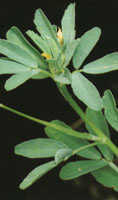View crop
View crop Data sheet EcoPortTrigonella foenum-graecum
 |
|
| Notes |
|---|
| BRIEF DESCRIPTION An erect, mooth, herbaceous plant that can grow up to 40-80 cm tall. The plant and seeds have a characteristic strong odour. The plant has compound leaves, 7-12 cm long. The flowers are white or purplish blue. The fruits occur as pods of 2-10 cm, long, thin and pointed and contain 10-20 seeds. USES The seeds are edible and used as condiments and as flavoring in artificial maple syrup, cheese and curries. An oil can be extracted from the seeds and used to flavor butterscotch, cheese, licorice, pickles, rum, syrup and vanilla. This oil has potential in the perfume and cosmetic industries. The seeds also contain the drug diospenin, used in the synthesis of hormones. Seed husks are a source of mucilage, oil, sapogenin and protein. Residue is used as manure and fuel. In India, plants are grown for forage. GROWING PERIOD Annual, ripens 90-150 days after planting. In India, where grown for forage, October plantings are harvested in February-March, while January plantings are harvested in April. COMMON NAMES Fenugreek, Fenugrec, Helba. FURTHER INF Fenugreek is indigenous to southern Europe and western Asia. The expected yield of seed is 0.5-3.8 t/ha. In India, yields of green forage are about 9-10 t/ha. Mentioned as a useful agroforestry species. | Sources |
| Grassland Index Roecklein J 1987 pp 390 [USE, DEP, DRA, TEXT] Duke J 1975 pp 30 [PH, RAIN, TEMP] Sims D (pers. comm.) Duke J 1981 pp 268-271 [DRA, FER, SAL, KTMP, TEXT, DEP, RAIN, TEMP, PH] Hornok L 1992 pp 289-290 [DEP, TEMP, RAIN, LIG, FER, DRA, USE] Bermejo J 1994 pp 281 & 287 [RAIN, TEMP, DRA, DEP, TEXT, PH] Iwu M 1993 pp 253-254 [USE] |